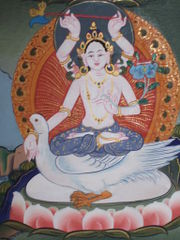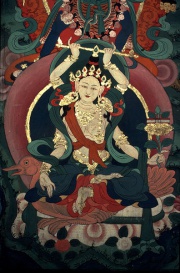Sitavijayatārā: Unterschied zwischen den Versionen
Adm1 (Diskussion | Beiträge) |
Admdb1 (Diskussion | Beiträge) K (Textersetzung - „<historylink type="back" style="font-family: Arial, Helvetica, sans-serif; font-size: 14px; color: #ffffff; padding: 4px 8px; float:right; background: -moz-linear-gradient( top, #fcf9fc 0%, #6a75eb); background: -webkit-gradient( linear, left top, left bottom, from(#fcf9fc), to(#6a75eb)); -moz-border-radius: 30px; -webkit-border-radius: 30px; border-radius: 30px; border: 3px solid #ffffff; -moz-box-shadow: 0px 3px 11px rgba(240,237,240,0.5), inset 0px 0px 1px rgba(000,145,255,1); -webkit-box-shadow: 0px 3px 11px rgba(240,237,240,0.5), inset 0px 0px 1px rgba(000,145,255,1); box-shadow: 0px 3px 11px rgba(240,237,240,0.5), inset 0px 0px 1px rgba(000,145,255,1); text-shadow: 0px -1px 0px rgba(000,000,000,0.2), 0px 1px 0px) |
||
| Zeile 32: | Zeile 32: | ||
* FPMT : [//fpmt.org/wp-content/uploads/prayers/21tarasltrrdr.pdf Praises to the 21 taras] | * FPMT : [//fpmt.org/wp-content/uploads/prayers/21tarasltrrdr.pdf Praises to the 21 taras] | ||
< | <historylink> | ||
[[Kategorie:Vajrayana]] | [[Kategorie:Vajrayana]] | ||
[[Kategorie:Tara]] | [[Kategorie:Tara]] | ||
Version vom 15. Dezember 2017, 18:35 Uhr
18. Die Sitavijayatārā oder Prapuṣṭi-Tārā (Rab tu rgyas pa’i Sgrol ma; Tārā des All-Anwachsenden) zählt zu den 21 Taras.
Darstellung
Ikonografisch wird sie auf einem weißen Lotus mit einem Mond und einer Gans dargestellt.
Aus dem GI erscheint eine weisse Tara mit vier Armen. Das erste Paar ihrer Hände hält einen Hakenstab über der Krone.
Das zweite Paar ist in wunscherfüllender Geste und hält einen Lotus mit einem Buch.
Sie sitzt in Sattva - Haltung.
Sadhana
Die Sitavijayatārā entsprechende Buddhaform ist Amithāba.
Ihr langes Mantra ist Oṃ tāre tuttāre ture nāga viṣa śāntiṃ kuru svāhā.
Lobpreisung
Verehrung ihr, die in den Händen den Mond mit dem Zeichen des Hasens hält,
der wie ein göttlicher See aussieht,
mit zweimal gemurmeltem TARA und PHAT
beseitigt sie alles Gift restlos.
Weblinks
- 21 taras of Suryagupta
- Viet Nalanda Foundation : Hai Mươi Mốt Quan Âm Tara
- 21 Tara-Lobpreisungen
- FPMT : Praises to the 21 taras
<historylink>

